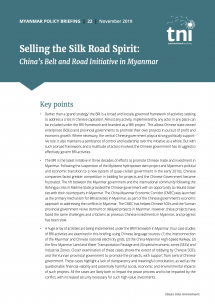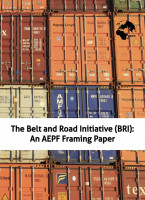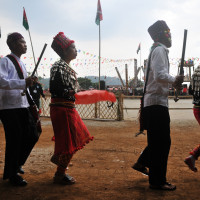Selling the Silk Road Spirit China’s Belt and Road Initiative in Myanmar
This briefing aims to deepen discussion on the Belt and Road Iniatiative (BRI) in Myanmar. The BRI is often described as a ‘grand strategy’ led by President Xi Jinping, centrally planned and rolled out by obedient state-owned enterprises (SOEs). The sheer size of the initiative – 136 countries have received US$90 billion in Chinese foreign direct investment and exchanged US$6 trillion in trade with China - can make the BRI appear monolithic and inevitable. However, using a political economy analysis, this briefing demonstrates that the BRI is not a grand strategy, but a broad framework of activities that seek to address a crisis in Chinese capitalism. An examination of four BRI projects in Myanmar using Chinese language sources shows the extent of lobbying by Chinese SOEs and the Yunnan provincial government to promote the projects, with support from the central Chinese government.

Downloads
Key points
- Rather than a ‘grand strategy’ the BRI is a broad and loosely governed framework of activities seeking to address a crisis in Chinese capitalism. Almost any activity, implemented by any actor in any place can be included under the BRI framework and branded as a ‘BRI project’. This allows Chinese state-owned enterprises (SOEs) and provincial governments to promote their own projects in pursuit of profit and economic growth. Where necessary, the central Chinese government plays a strong politically supportive role. It also maintains a semblance of control and leadership over the initiative as a whole. But with such a broad framework, and a multitude of actors involved, the Chinese government has struggled to effectively govern BRI activities.
- The BRI is the latest initiative in three decades of efforts to promote Chinese trade and investment in Myanmar. Following the suspension of the Myitsone hydropower dam project and Myanmar’s political and economic transition to a new system of quasi-civilian government in the early 2010s, Chinese companies faced greater competition in bidding for projects and the Chinese Government became frustrated. The rift between the Myanmar government and the international community following the Rohingya crisis in Rakhine State provided the Chinese government with an opportunity to rebuild closer ties with their counterparts in Myanmar. The China-Myanmar Economic Corridor (CMEC) was launched as the primary mechanism for BRI activities in Myanmar, as part of the Chinese government’s economic approach to addressing the conflicts in Myanmar. The CMEC has helped Chinese SOEs and the Yunnan provincial government revive dormant or delayed projects in Myanmar. However, these projects have faced the same challenges and criticisms as previous Chinese investments in Myanmar, and progress has been slow.
- A huge array of activities are being implemented under the BRI framework in Myanmar. Four case studies of BRI activities are examined in this briefing, using Chinese language sources: (1) the interconnection of the Myanmar and Chinese national electricity grids, (2) the China-Myanmar High-Speed Railway, (3) the Sino-Myanmar Land and Water Transportation Passage and (4) special economic zones (SEZs) and Industrial Zones. Closer examination of these cases shows the extent of lobbying by Chinese SOEs and the Yunnan provincial government to promote the projects, with support from central Chinese government. These cases highlight a lack of transparency and meaningful consultation, as well as the questionable financial viability and potentially harmful social, economic and environmental impacts of such projects. All the cases are likely both to impact the peace process and to be impacted by the conflict, with increased security necessary for such high-value investments.
- Given the BRI’s character as a broad framework of activities, rather than a predetermined plan, there are opportunities for the Myanmar government and civil society organisations (CSOs) to influence BRI activities in the country. The Myanmar government has already shown that this is possible with their insistence on an open tendering process for the Muse-Mandalay Railway. CSOs in other countries have also been able to halt harmful projects, for instance by highlighting their unsustainability and lack of financial viability to Chinese banks and other government bodies.
- The current legal and policy framework for regulating foreign investment in Myanmar is weak and mostly benefits companies rather than local communities. Existing land laws, for instance, do not recognise ethnic customary tenure systems even while many of the country’s natural resources attracting foreign investment are located within ethnic nationality areas. Government regulations on proper consultation processes, environmental standards, compensation and other key issues related to foreign investment are also either inadequate or non-existent. As a result, foreign investment projects have faced resistance from local communities.
- A significant number of BRI activities are taking place in conflict-affected areas. This includes areas of armed conflict as well as communal conflict. It is important that any foreign investment does not have negative impacts on these conflicts. Activities should not lead to increased militarisation to ‘protect’ foreign investment, nor should they contribute to exacerbating existing conflicts or creating new ones.

